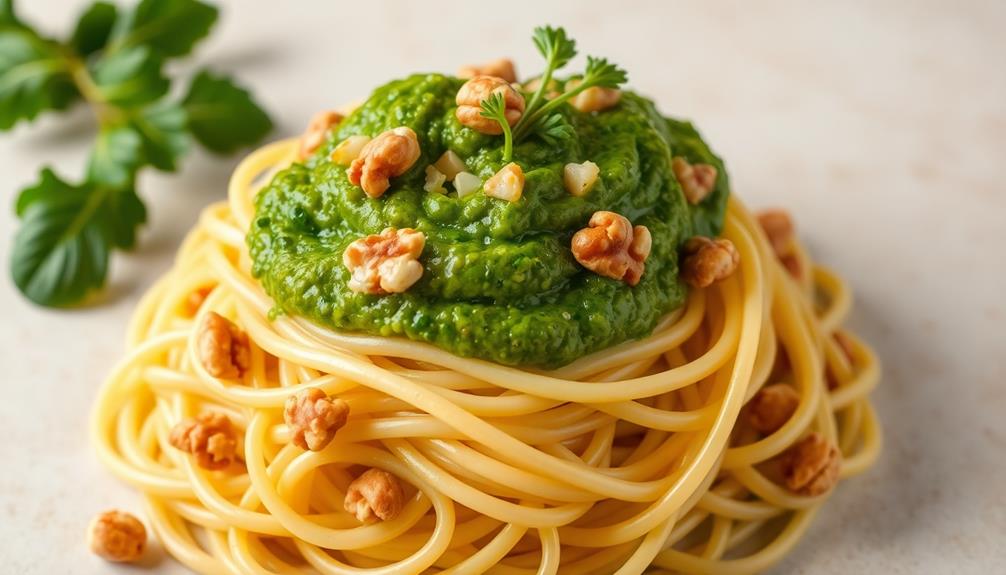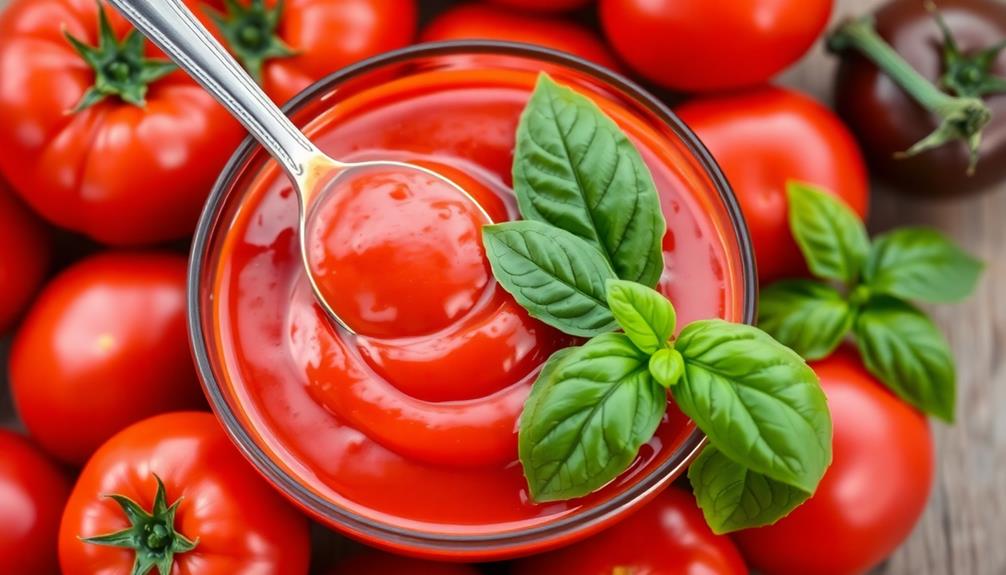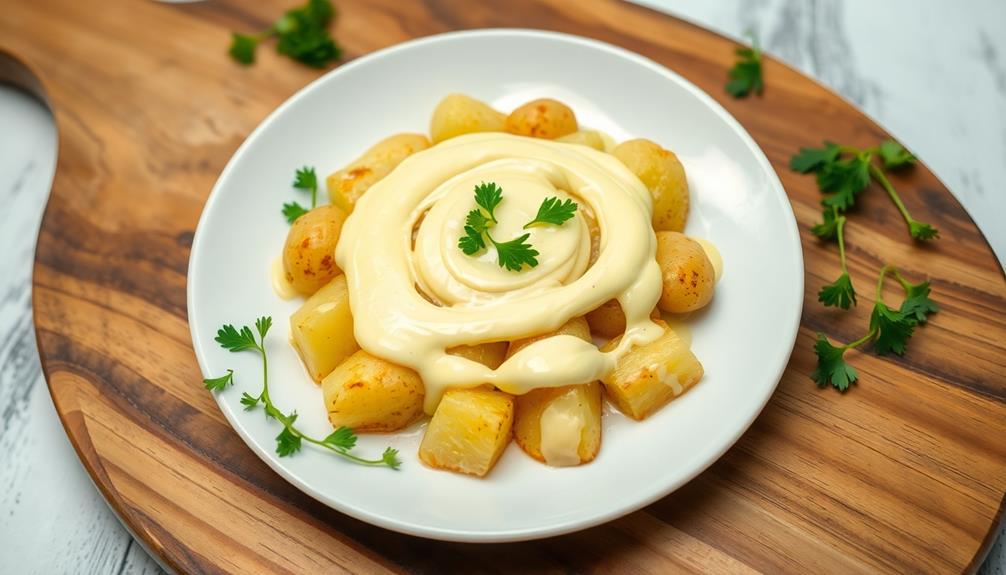You're in for a real treat, because pesto isn't just about basil anymore! This vibrant sauce originated in Genoa, Italy, but has since spread its wings around the world. While the classic version features basil, garlic, pine nuts, and Parmesan, modern pesto cooks are experimenting with all sorts of tasty ingredients. You can now find pestos made with spinach, arugula, sun-dried tomatoes, and even walnuts or almonds. The possibilities are endless when it comes to crafting unique flavor combinations. Pesto's versatility means you can enjoy it in so many ways – as a sandwich spread, pasta sauce, dip, and more. And there's even more to discover…
Key Takeaways
- Pesto's origins in Genoa, Italy, and how it has evolved beyond the classic basil-based recipe.
- Diverse pesto varieties made with alternative herbs, greens, nuts, and cheeses to suit different tastes and dietary needs.
- The versatility of pesto in enhancing a wide range of dishes, from sandwiches to soups and grilled meats.
- Techniques for toasting nuts and incorporating cheese and olive oil to create a rich, creamy pesto texture.
- Tips for storing and preserving homemade pesto to maximize its shelf life and convenience for future use.
History
Pesto, the beloved Italian sauce, has a rich and storied history that dates back centuries. You might be surprised to learn that this vibrant, fragrant sauce originated not in Italy, but in the coastal region of Genoa, in northwestern Italy.
The earliest versions of pesto were simply a mixture of crushed garlic, pine nuts, salt, and olive oil – a simple, yet delicious, combination of flavors.
As pesto grew in popularity, cooks began experimenting with different ingredients, including the now-iconic basil leaves. This classic green pesto became a beloved staple in Italian cuisine, spreading throughout the country and eventually, the world.
Today, pesto can be made with a variety of herbs, nuts, and cheeses, allowing for endless creative possibilities. Whether you prefer the traditional basil version or a unique spin, pesto's history is one that celebrates the joy of fresh, flavorful ingredients coming together in perfect harmony.
Recipe
Pesto is a versatile sauce that can be made with a variety of herbs and nuts. While the classic basil pesto is a beloved favorite, exploring alternative pesto options can open up a world of culinary possibilities.
This recipe showcases a delightful pesto made with spinach, walnuts, and Parmesan cheese. The rich, creamy texture of this pesto pairs beautifully with pasta, as a spread on bread, or even as a topping for grilled meats or roasted vegetables.
Ingredients:
- 2 cups fresh spinach leaves
- 1/2 cup walnuts
- 1/2 cup grated Parmesan cheese
- 2 cloves garlic
- 1/4 cup olive oil
- 1/4 teaspoon salt
- 1/4 teaspoon black pepper
Instructions:
In a food processor, combine the spinach, walnuts, Parmesan cheese, and garlic. Pulse until a coarse paste forms.
Slowly drizzle in the olive oil while the processor is running, and continue to blend until the pesto reaches the desired smooth and creamy consistency.
Season with salt and black pepper.
When making this spinach and walnut pesto, be mindful that the flavors can be quite robust. Start with a small amount of garlic and adjust to your personal taste preferences.
Additionally, consider toasting the walnuts briefly to enhance their nutty aroma and flavor.
This pesto can be stored in the refrigerator for up to a week, or frozen for longer-term use.
Cooking Steps
Let's get cooking!
First, toast those nuts to bring out their nutty flavor.
Then, add the pine nuts, cheeses, and olive oil to create a creamy, delicious pesto.
Step 1. Toast the Nuts
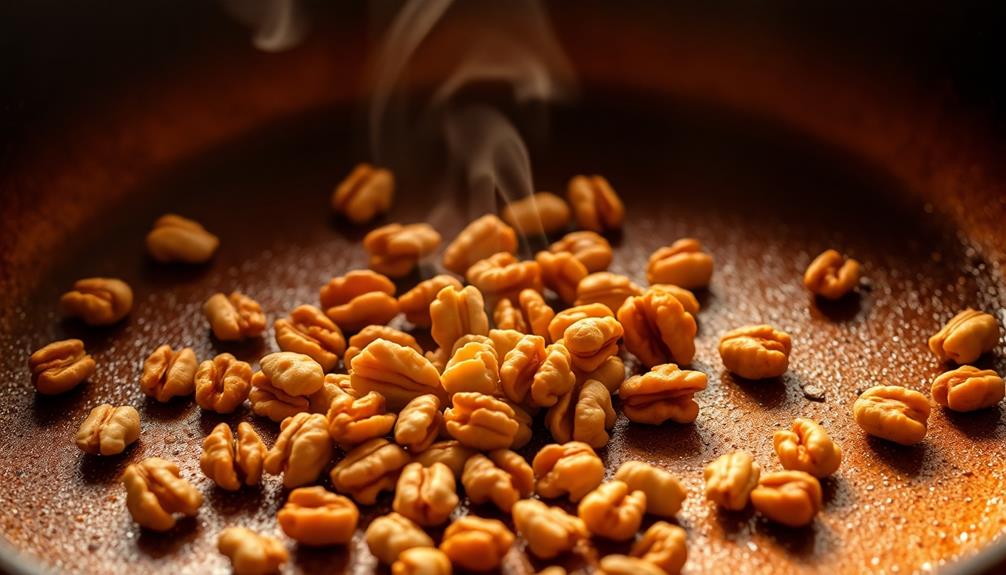
Toasting the nuts brings out their natural oils and deepens their flavor. It's a simple step that takes just a few minutes but makes a big difference in your pesto.
Simply place the nuts in a dry skillet over medium heat. Keep a close eye on them, stirring frequently, until they become fragrant and start to turn golden brown. Be careful not to let them burn – that can make the pesto taste bitter.
Once the nuts are perfectly toasted, transfer them to a plate or bowl to cool slightly. You'll be able to smell their rich, nutty aroma.
This step is important because it intensifies the nut flavor in your pesto. The toasted nuts will also give the pesto a heartier texture.
Now you're ready to add the rest of the ingredients and whip up a batch of delicious pesto. Get ready for the flavors to explode in your mouth!
Step 2. Add Pine Nuts
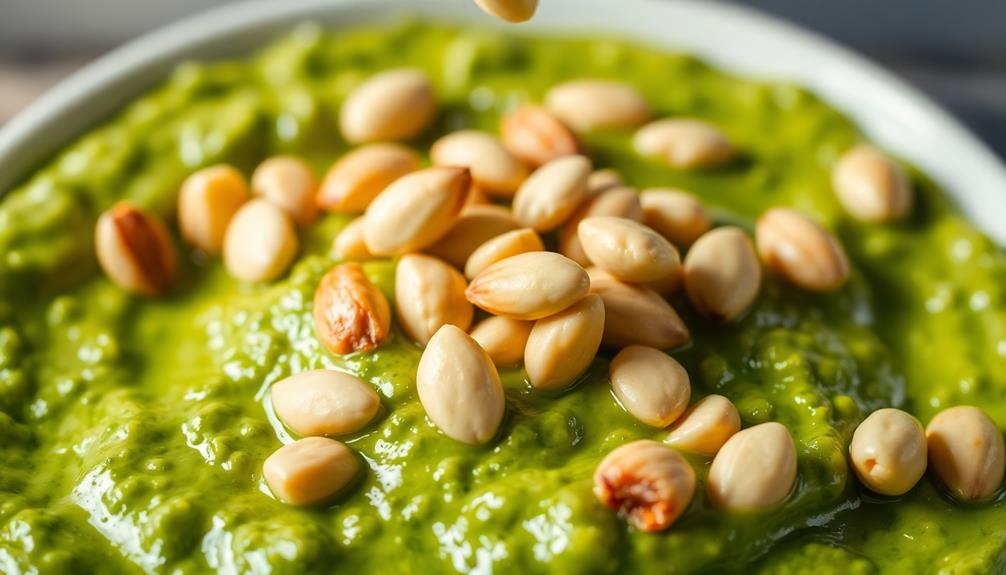
Once the nuts are toasted to perfection, you'll add the pine nuts to the mix. These little nuggets of deliciousness will take your pesto to the next level! Pine nuts have a buttery, almost sweet flavor that pairs beautifully with the basil and garlic.
Regular cleaning is essential for optimal performance, just like maintaining your kitchen tools can enhance your cooking experience; think about how air purifier maintenance can improve your home environment.
Carefully pour the pine nuts into the food processor or blender, making sure they get evenly distributed. As the blades whir, you'll start to smell the irresistible aroma of the nuts blending with the other ingredients.
Keep an eye on the consistency – you want it to be smooth and creamy, but not too thin.
Now's the time to give your pesto a taste test. Dip a spoon in and see how the flavors meld together. If it needs a little something extra, feel free to add a pinch more of salt or a squeeze of lemon juice.
With the pine nuts in the mix, your pesto is going to be out of this world delicious!
Step 3. Add Cheese and Olive Oil

Next, you'll want to add the cheese and olive oil. This is where the pesto really starts to come together!
First, grab a nice chunk of Parmesan cheese and grate it up. The salty, nutty flavor of the Parmesan pairs perfectly with the fresh basil. Go ahead and add a good amount – you'll want about a 1/2 cup of grated Parmesan.
Now for the olive oil. This is what's going to give your pesto a smooth, creamy texture. Drizzle in about 1/4 cup of high-quality extra virgin olive oil.
Swirl it around and watch as the ingredients start to blend together into a vibrant green sauce. The olive oil will help bind everything and make your pesto nice and spreadable.
Give it a good stir to combine all the flavors. Mmm, can you just imagine how delicious this is going to taste?
Get ready, because you're about to have the best pesto of your life!
Step 4. Add Parmesan Cheese
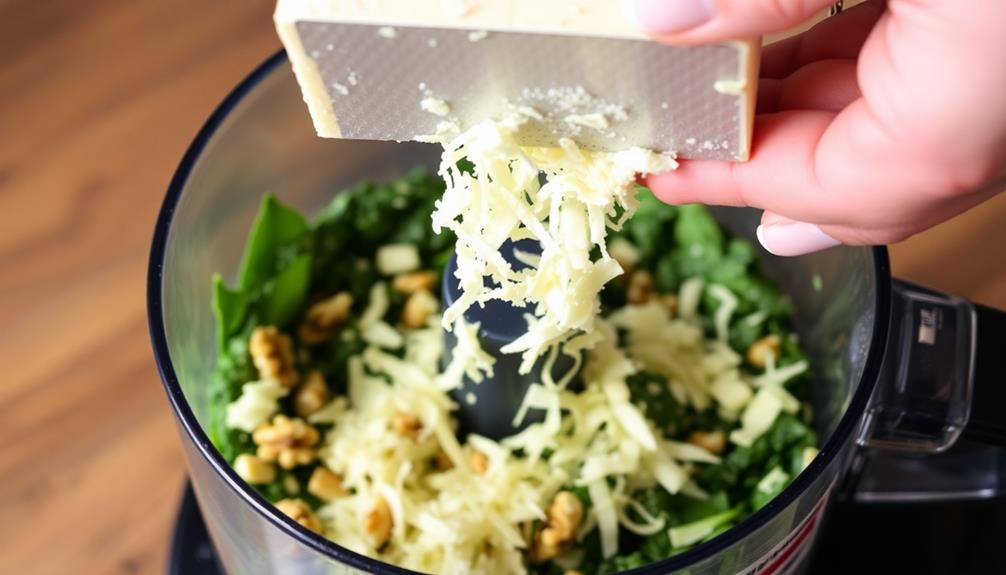
Grab a nice chunk of Parmesan cheese and grate it up. You'll want about a half-cup of the deliciously salty and nutty cheese.
Parmesan is the perfect addition to your pesto, adding a savory depth that complements the fresh basil. As you grate, the cheese will create a fine, powdery texture that will blend seamlessly into the pesto.
Now, measure out your olive oil and add it to the food processor. The Parmesan and olive oil will create a creamy, emulsified texture that coats each basil leaf.
Pulse the mixture until it reaches your desired consistency – some people like it chunky, others smooth.
Don't be afraid to add a little more Parmesan if you want an extra cheesy kick. The saltiness of the Parmesan pairs beautifully with the aromatic basil, creating a pesto that's bursting with flavor in every bite.
Get ready for your taste buds to do a happy dance!
Step 5. Add Fresh Basil
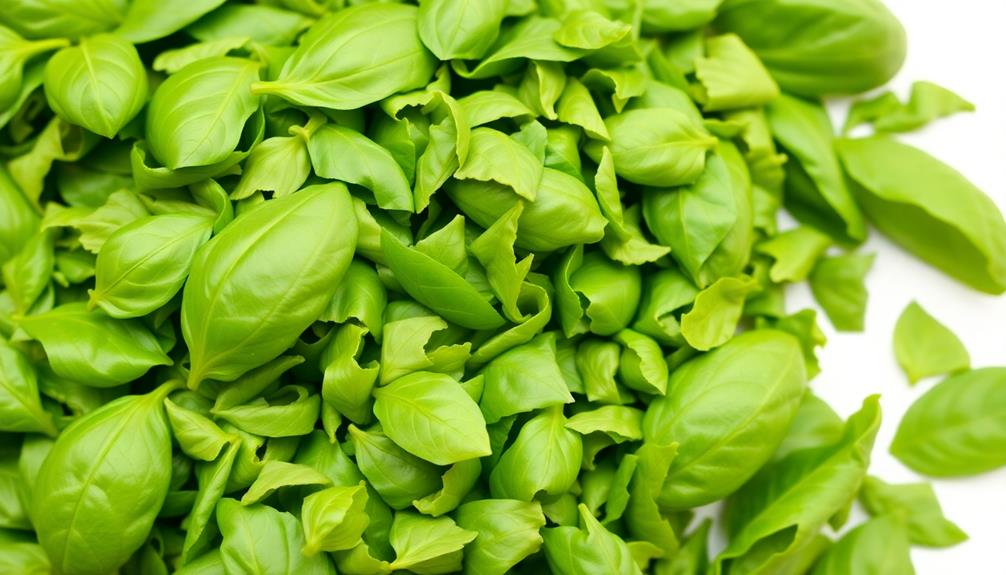
The basil leaves are the foundation of pesto, so be sure to handle them with care. Gently pluck the delicate leaves from the stems, avoiding any bruising or tearing. Rinse the leaves under cool, running water, then pat them dry with a clean towel. This will help remove any dirt or impurities, ensuring your pesto has a bright, fresh flavor. Fresh basil is also known for its antioxidant properties, which can contribute to overall health beneficial properties of herbs.
Now, it's time to chop the basil. Gather the leaves and stack them neatly. Using a sharp knife, carefully slice the basil into thin ribbons. This technique, called chiffonade, will create a lovely texture and uniform distribution throughout your pesto. Be mindful of your fingers as you work – the basil leaves are slippery, so take your time and keep those fingers tucked safely away.
Once your basil is perfectly prepped, you're ready to blend it into a silky, fragrant pesto. The fresh, vibrant green color will bring a burst of summer sunshine to your dish. Get ready to savor the delicious flavors of this classic Italian staple!
Final Thoughts
With countless ways to make pesto, the possibilities are truly endless. You can use all sorts of herbs, nuts, cheeses, and oils to create your own unique blends. Basil is just the beginning – why not try cilantro, parsley, or even arugula pesto? The options are as endless as your imagination.
Pesto is also super versatile. Spread it on sandwiches, toss it with pasta, or even use it as a dip for veggies. It adds a burst of fresh, flavorful goodness to any dish. You can even use pesto in non-traditional ways, such as in a marinade for grilled chicken or as a topping for pizza. It’s also a delicious addition to a classic matzo ball soup recipe. The nutty, herbaceous flavor of the pesto adds an extra dimension to the comforting soup, making it a standout dish.
And don't forget, pesto freezes beautifully, so you can make big batches and enjoy it all year round.
Frequently Asked Questions
How Long Does Homemade Pesto Last in the Refrigerator?
Homemade pesto can last in the refrigerator for up to a week when stored in an airtight container. The key is to keep it chilled and avoid exposing it to air, which can cause it to oxidize and spoil.
Can I Freeze Pesto for Later Use?
Yes, you can freeze homemade pesto for later use. Simply store it in an airtight container or freezer bag and it'll keep in the freezer for up to 6 months. Thaw in the refrigerator before using.
What Are the Best Substitutes for Pine Nuts in Pesto?
The best substitutes for pine nuts in pesto are walnuts, almonds, or cashews. You can easily swap them in, and they'll give your pesto a similar texture and flavor. Just adjust the quantity to your taste.
Can I Use Different Types of Cheese in Pesto?
Absolutely! You can use different types of cheese in pesto. Try using Parmesan, pecorino, or even goat cheese to add a unique flavor to your pesto. Experiment with different cheeses to find your favorite combination.
How Can I Adjust the Flavor of Pesto to My Taste?
To adjust the flavor of pesto to your taste, you can experiment with different types of nuts, herbs, and cheeses. Add more or less garlic, lemon juice, or olive oil to balance the flavors.
